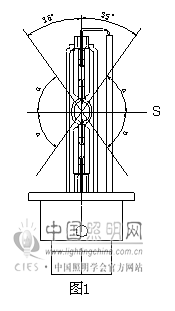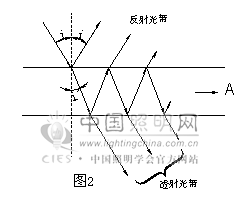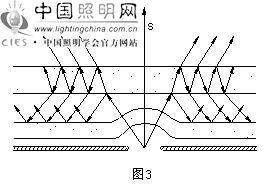Guangdong Xuelaite Optoelectronics Technology Co., Ltd.
Abstract: a commercially available xenon metal halide lamp is used as the mechanism of the headlight glare large, a large proportion of the proposed new headlight glare-reducing design, gives the measured data and compare the two.
Keywords: headlights, xenon metal halide lamps, glare
I Introduction
At present, commercial Xenon metal halide lamps are mostly designed according to Phillips patent [1][2][3][4][5][6][7]. Such lamps are commonly known as xenon headlights, headlights, HID lamps, and the like. Because of its popularity and popularity with respect to many advantages of conventional tungsten halogen lamps, its main advantages can be demonstrated by the following table data. Compared with tungsten halogen lamps, Xenon metal halide lamps emit ten times the life and half the power. Triple the light. Japanese statistics also show that the adoption of such high-intensity discharge lamps has significantly reduced the accident rate at night. This obvious advantage makes it understandable to replace traditional tungsten halogen lamps at such a fast speed.
Lamp type | Power (W) | Luminous flux (Lm) | Light efficiency (lm/w) | Color temperature (K) | Spot size (mm) | Life (h) |
Tungsten halogen lamp | 55-100 | 1000-2000 | 15-20 | <3000 | 5.5-8 | 300 |
Headlights | 35 | 3200 | >90 | 4100-6000 | 4.3 | 3000 |
 Philips' lamp structure is a very successful design, the standard structure of which is shown in Figure 1. The arc tube has an equivalent inner diameter of less than 4 mm, so that the small arc tube size reaches 90 lm/w or even more than 100 lm/w. And the life expectancy can reach 3000-4000 hours, which is the design success, and it is also guaranteed by extremely strict material formula and extremely exquisite and strict processing technology. Although the quality of commercially available Xenon metal halide lamps is generally inferior, this is not a design error and is caused by poor process technology.
Philips' lamp structure is a very successful design, the standard structure of which is shown in Figure 1. The arc tube has an equivalent inner diameter of less than 4 mm, so that the small arc tube size reaches 90 lm/w or even more than 100 lm/w. And the life expectancy can reach 3000-4000 hours, which is the design success, and it is also guaranteed by extremely strict material formula and extremely exquisite and strict processing technology. Although the quality of commercially available Xenon metal halide lamps is generally inferior, this is not a design error and is caused by poor process technology. While widely replacing halogen lamps with Xenon metal halide lamps, it has been found that this type of lamp is used for headlight illumination. An obvious problem is that the glare is too strong, which affects the oncoming vehicle driver's vision and affects driving safety. . Traffic management departments in some regions have imposed restrictions on this, such as not allowing vehicles to convert tungsten halogen lamps into xenon metal halide lamps or disallowing such high-efficiency long-life lamps for high-beam illumination.
Many car light experts believe that the Xenon metal halide lamp is too bright, so it will inevitably produce a lot of glare. The glare is an inevitable product of this kind of lamp. To use its advantages, it has to tolerate its shortcomings. It turns out that this view is not comprehensive.
II imperfect design is the root cause of a lot of glare.
 According to the Philips patented Xenon metal halide lamp, the outer casing is made of a straight cylindrical quartz tube. The patent and the distance between the outer casing and the arc tube are between 0.5 and 2 mm (the actual size is about 0.5 mm). Since the arc tube shell is not parallel to the outer casing, the light emitted by the arc tube will be reflected and refracted by the incident angle i ≠0 when it reaches the outer casing. The case where the oblique incident beam is reflected and refracted on the surface of the medium is shown in Fig. 2. A beam of light incident at the i-angle is reflected and refracted by the glass, and is converted into a reflected light band that is reflected at the i-angle and attenuated in the A direction, and a transmitted light band that is also attenuated in the A direction at the i' angle.
According to the Philips patented Xenon metal halide lamp, the outer casing is made of a straight cylindrical quartz tube. The patent and the distance between the outer casing and the arc tube are between 0.5 and 2 mm (the actual size is about 0.5 mm). Since the arc tube shell is not parallel to the outer casing, the light emitted by the arc tube will be reflected and refracted by the incident angle i ≠0 when it reaches the outer casing. The case where the oblique incident beam is reflected and refracted on the surface of the medium is shown in Fig. 2. A beam of light incident at the i-angle is reflected and refracted by the glass, and is converted into a reflected light band that is reflected at the i-angle and attenuated in the A direction, and a transmitted light band that is also attenuated in the A direction at the i' angle. It is inferred that in the Xenon metal halide lamp, it can be seen from Fig. 3 that for a straight tubular outer casing lamp, only the light radiating from the central portion of the arc tube, and the direction in the plane S passing through the center and perpendicular to the lamp axis will not reflect. Direct radiation. All light whose radiation direction does not coincide with the plane will become stray light that deviates from the original radiation location and radiates around the two ends of the arc tube and extends toward both ends. It can be seen that the light in the 2α solid angle (110°) normally collected for the luminaire as shown in Fig. 1 cannot be projected into the beam forward. The light scattered to the two ends due to the refraction and reflection of the outer casing will be added to 2α. In addition to the angle, that is, the ineffective radiation light within the 35° cone angle with the lamp axis as the axis. In addition, the quartz wall of the outer casing and the contracted neck of the arc tube at both ends will form a light guide to direct the light to both ends and radiate. More than 1/4 of all the above-mentioned stray light will become glare radiating forward and upward. This is the reason why such a light source produces strong glare.

